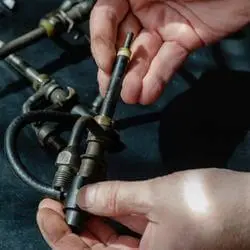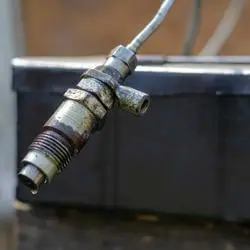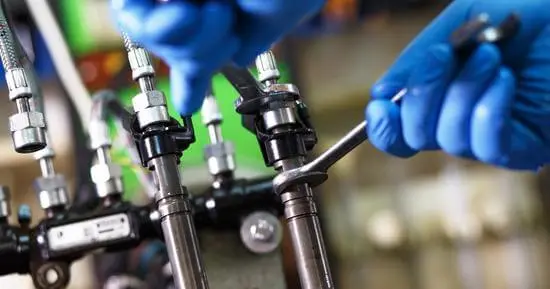It is essential to check an Injector pulse with a multimeter to ensure that your vehicle’s fuel injector is working correctly. An injector pulse is a short, high-potential spark of electricity given to your car’s injector on the engine computer’s command. In this article, you will find how to check the injector pulse with a multimeter and the reasons behind the defective working of the fuel injector.
Here are the quick steps below to test injectors:
- Start up the engine and allow it to warm up for a few minutes.
- Turn off your vehicle and disconnect the auto-accessories.
- To prevent unexpected shorts, ensure that the negative terminal of the battery of the vehicle is disconnected.
- Connect the fuel line with the fuel injector.
- Connect the multimeter to the positive terminal of the vehicle’s battery.
- Note the reading shown by the multimeter; the reading should be 12 volts.
- Connect the multimeter to the negative terminal of the vehicle’s battery. The multimeter will show no reading at this terminal.
Table of Contents
ToggleWhat are fuel injector, and hows it works?
A fuel injector is equipment that distributes fuel into the vehicle’s internal engine in a standard way. The primary purpose of the fuel injector is to tolerate the intense pressure of the internal environment of the engine of the vehicle.
A fuel injector ensures the limit of fuel discharge that fuel is delivered to the combustion engine at the correct limit at the proper time. If there is any defect in the fuel engine, it will cause severe damage to the engine of the vehicle. So, you must know how to check the injector pulse with a multimeter.
What is an Injector pulse, and how it works?
The engine computer controls the intensity of the injector’s pulse, which directly impacts the amount of fuel delivered. The injector pulse of the fuel injector is the short, potential solid electric spark. So it is necessary to check the injector pulse with a multimeter.
The engine of a vehicle consists ECU, an electronic control unit. ECU helps in monitoring the speed and load of the motor. The primary function of ECU is to calculate the standard time to deliver an injector pulse. ECU plays a central role in increasing the working of an engine.
Essential tool kit for injectors test
The following tools are essential to check the injector pulse with a multimeter.
- A multimeter
- A test light
- A connector kit for the injector
- A piece of a probe or wire
Methods to check an injector pulse
If your vehicle’s fuel injector is not working correctly, it will cause severe damage to the engine. So you must check the working of the injector to ensure that the fuel injector is working correctly. Here you will find some methods to test an injector pulse.
- Test injector pulse with a Multimeter.
- Test injector pulse with a Test light.
How to test the injector pulse with a multimeter?
- Start up the engine of your vehicle and let it warm up.
- Remove the connection of all accessories connected to the car and turn off your vehicle.
- Disconnect the negative terminal of the vehicle’s battery to prevent an unexpected burst.
- Connect the fuel injector with the fuel line.
- Connect the positive terminal of the car’s battery with a multimeter.
- The multimeter will show a reading of 12 volts.
- Similarly, connect the negative terminal of the vehicle’s battery with a multimeter.
- The multimeter will not show any voltage.
- Check for a fuse or wire if both ends of the vehicle’s battery do not display power.
- If the multimeter shows power at both terminals of the vehicle’s battery, your injector is not working correctly. Replace the defective injector immediately.
How to test the injector pulse with a test light?
- Start up the engine of your vehicle and let it warm up.
- Remove the connection of all accessories connected to the car and turn off your vehicle.
- Disconnect the negative terminal of the vehicle’s battery to prevent an unexpected burst.
- Connect the fuel injector with the fuel for a line.
- Connect the positive terminal of the vehicle’s battery with a test light.
- The test light will glow when you connect it to the positive terminal.
- Similarly, connect the test light to the negative terminal of the vehicle’s battery.
- The test light will not glow at the negative terminal.
- If one of the terminals is not showing power, check the wire or fuse.
- If both terminals display power, then the injector is defective.
Which tools are used to replace an injector
When to check an injector pulse with a multimeter and find that the injector of your vehicle’s engine is defective and needs to be replaced immediately, you will need the following tools.
- A socket
- A ratchet
- A tool used to disconnect the fuel line
- Hand tools like wire cutters
- A new injector
How to replace the Injector
- Place your vehicle on a flat surface.
- Lift your car with the help of a jack.
- The fuel injector is fixed with the fuel line having a series of bolts.
- Remove the bolts using a socket and ratchet.
- Lose the fuel line using a fuel line disconnect tool.
- Remove the defective injector.
- Install a defect-free injector.
- Remove the jack and park your vehicle in the stable position.
- Check any leaks after installing a new injector and fix them immediately.
Tips to increase the lifespan of an injector
If you want to increase the lifespan of your vehicles injector, follow the following tips:
- Tidy up the injector from time to time.
- Check your engines computer system to ensure that it is working properly
- Avoid the use of low-quality fuel.
Conclusion
This article provides you with all the information about how to check an injector pulse with a multimeter. If you check an injector of a vehicle regularly, it will prevent your engine from severe damage. Also, you will not suffer any problems while on the road.
Related Guides:






